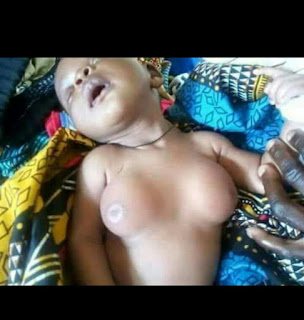Infant breasts: Premature Telarche
A very hysterical parent came running to the hospital when they observed the persistent growing of their 8 months old baby's breasts, they needed answers to douse their fears. So the doctor requested for a breast examination for the infant. Ultrasound report shows no unusual growth, cyst or malign/benign mass. It was just normal breasts tissue.
It's normal for newborn babies (boys and girls) to have swollen, enlarged breasts and/or lumps under the nipple. They're almost always benign and due to exposure to maternal hormones in the womb. The same hormones that cause the mother's breasts to swell and stimulates milk glands can do the same to the baby's breasts.
What is premature thelarche?
Premature thelarche is enlargement of the breasts in infant girls. Most often, breast enlargement is the only abnormality. It is occasionally the first sign of early (precocious) puberty. This is more likely if the breasts become enlarged after ages 2 to 3. Usually there is no apparent cause of early breast enlargement, although it can result from exposure to medications or to sources of the hormone estrogen. The breasts may remain enlarged for as long as a few years but eventually go down in size before your child starts puberty.
What does it look like?
Your child's breasts start getting bigger. One or both breasts may be enlarged. They may go up and down in size. Breast enlargement usually occurs before age 2. Occasionally, a baby girl is born with enlarged breasts. There are no other signs of puberty, for example, growth of pubic hair (hair around the genitals) or rapid body growth.
Medical tests, if performed, show no other signs of approaching puberty. Breasts eventually stop growing and may become reduced in size. It may take a few years before the breasts completely return to normal. Girls go on to have a normal puberty.
What causes premature thelarche?
Usually, no specific cause is identified. Premature breast enlargement can be caused by exposure to the hormone estrogen, for example, a child eating the mother’s birth control pills.
What are some possible complications of premature thelarche?
Usually none. The condition often goes away on its own, although this may take a few years. Infrequently, premature thelarche is the first sign of early (precocious) puberty. This is most likely when the breasts start to enlarge after ages 2 to 3, accompanied by other signs of puberty such as an enlarged clitoris or development of pubic hair. Treatment may be needed to halt the process of early maturation.
What puts your child at risk of premature thelarche? There are no known risk factors.
Can premature thelarche be prevented? There is no way to prevent this condition.
How is premature thelarche treated? Usually, no treatment is needed. Your child’s breasts will eventually go down in size or stop enlarging. Your doctor will examine your child for any other signs of puberty. Medical tests are usually not needed. If the doctor has any reason to suspect an abnormality, various tests may be performed as well, such as measuring hormone levels, x-rays to assess bone growth, or ultrasound scans of the uterus and ovaries.
The doctor will continue to monitor your daughter to make sure there are no other signs of early puberty. If there is any reason to suspect a medical cause of early puberty, we will probably recommend a visit to an endocrinologist (a doctor specializing in the treatment of gland and hormone diseases). This specialist can perform tests and recommend treatments designed to interrupt the process of puberty, if necessary.
See you doctor if your child develops any of the following:
- Further enlargement and development of the breasts.
- Repeat enlargement of the breasts after they have gone down in size.
- Any other signs of early puberty, such as hair around the genital area and under the arms or very rapid bodily growth.





Thanks for sharing. This is serious.
ReplyDeleteWow, never heard of such before, it's a very serious matter
ReplyDeleteCan't they use hot water to press it since it's just swollen?